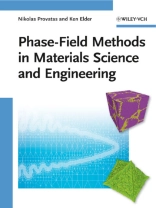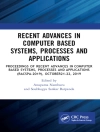This comprehensive and self-contained, one-stop source discusses phase-field methodology in a fundamental way, explaining advanced numerical techniques for solving phase-field and related continuum-field models. It also presents numerical techniques used to simulate various phenomena in a detailed, step-by-step way, such that readers can carry out their own code developments.
Features many examples of how the methods explained can be used in materials science and engineering applications.
Spis treści
Preface xi
1 Introduction 1
1.1 The Role of Microstructure Materials Science 1
1.2 Free Boundary Problems and Microstructure Evolution 2
1.3 Continuum versus Sharp Interface Descriptions 5
References 7
2 Mean Field Theory of Phase Transformations 9
2.1 Simple Lattice Models 10
2.1.1 Phase Separation in a Binary Mixture 10
2.1.2 Ising Model of Magnetism 13
2.2 Introduction to Landau Theory 17
2.2.1 Order Parameters and Phase Transformations 17
2.2.2 The Landau Free Energy Functional 18
2.2.3 Phase Transitions with a Symmetric Phase Diagram 20
2.2.4 Phase Transitions with a Nonsymmetric Phase Diagram 22
2.2.5 First-Order Transition without a Critical Point 24
References 25
3 Spatial Variations and Interfaces 27
3.1 The Ginzburg–Landau Free Energy Functional 27
3.2 Equilibrium Interfaces and Surface Tension 29
References 32
4 Nonequilibrium Dynamics 33
4.1 Driving Forces and Fluxes 34
4.2 The Diffusion Equation 34
4.3 Dynamics of Conserved Order Parameters: Model B 35
4.4 Dynamics of Nonconserved Order Parameters: Model A 38
4.5 Generic Features of Models A and B 39
4.6 Equilibrium Fluctuations of Order Parameters 40
4.6.1 Nonconserved Order Parameters 40
4.6.2 Conserved Order Parameters 42
4.7 Stability and the Formation of Second Phases 42
4.7.1 Nonconserved Order Parameters 42
4.7.2 Conserved Order Parameters 44
4.8 Interface Dynamics of Phase Field Models (Optional) 45
4.8.1 Model A 45
4.8.2 Model B 49
4.9 Numerical Methods 50
4.9.1 Fortran 90 Codes Accompanying this Book 50
4.9.2 Model A 51
4.9.3 Model B 55
References 56
5 Introduction to Phase Field Modeling: Solidification of Pure Materials 57
5.1 Solid Order Parameters 57
5.2 Free Energy Functional for Solidification 60
5.3 Single Order Parameter Theory of Solidification 61
5.4 Solidification Dynamics 63
5.4.1 Isothermal Solidification: Model A Dynamics 63
5.4.2 Anisotropy 65
5.4.3 Nonisothermal Solidification: Model C Dynamics 66
5.5 Sharp and Thin Interface Limits of Phase Field Models 68
5.6 Case Study: Thin Interface Analysis of Equation 5.30 69
5.6.1 Recasting Phase Field Equations 70
5.6.2 Effective Sharp Interface Model 71
5.7 Numerical Simulations of Model c 73
5.7.1 Discrete Equations 74
5.7.2 Boundary Conditions 76
5.7.3 Scaling and Convergence of Model 77
5.8 Properties of Dendritic Solidification in Pure Materials 80
5.8.1 Microscopic Solvability Theory 81
5.8.2 Phase Field Predictions of Dendrite Operating States 83
5.8.3 Further Study of Dendritic Growth 87
References 87
6 Phase Field Modeling of Solidification in Binary Alloys 89
6.1 Alloys and Phase Diagrams: A Quick Review 89
6.2 Microstructure Evolution in Alloys 91
6.2.1 Sharp Interface Model in One Dimension 92
6.2.2 Extension of Sharp Interface Model to Higher Dimensions 93
6.3 Phase Field Model of a Binary Alloy 95
6.3.1 Free Energy Functional 95
6.3.2 General Form of f(ᵠ, c, T) 96
6.3.3 f(ᵠ, c, T) for Isomorphous Alloys 96
6.3.4 f(ᵠ, c, T) for Eutectic Alloys 97
6.3.5 f(ᵠ, c, T) for Dilute Binary Alloys 98
6.4 Equilibrium Properties of Free Energy Functional 99
6.4.1 Simple Example of a ‘‘Toy’’ Model 100
6.4.2 Calculation of Surface Tension 101
6.5 Phase Field Dynamics 103
6.6 Thin Interface Limits of Alloy Phase Field Models 104
6.7 Case Study: Analysis of a Dilute Binary Alloy Model 106
6.7.1 Interpolation Functions for f(Φ, c) 106
6.7.2 Equilibrium Phase Diagram 107
6.7.3 Steady-State c0 and Φ0 108
6.7.4 Dynamical Equations 109
6.7.5 Thin Interface Properties of Dilute Alloy Model 111
6.7.6 Nonvariational Version of Model (optional) 112
6.7.7 Effective Sharp Interface Parameters of Nonvariational Model (optional) 113
6.8 Numerical Simulations of Dilute Alloy Phase Field Model 116
6.8.1 Discrete Equations 116
6.8.2 Convergence Properties of Model 119
6.9 Other Alloy Phase Field Formulations 121
6.9.1 Introducing Fictitious Concentrations 122
6.9.2 Formulation of Phase Field Equations 123
6.9.3 Steady-State Properties of Model and Surface Tension 124
6.9.4 Thin Interface Limit 125
6.9.5 Numerical Determination of CS and CL 126
6.10 Properties of Dendritic Solidification in Binary Alloys 127
6.10.1 Geometric Models of Directional Solidification 127
6.10.2 Spacing Selection Theories of Directional Solidification 130
6.10.3 Phase Field Simulations of Directional Solidification 132
6.10.4 The Role of Surface Tension Anisotropy 137
References 141
7 Multiple Phase Fields and Order Parameters 143
7.1 Multiorder Parameter Models 144
7.1.1 Pure Materials 144
7.1.2 Alloys 146
7.1.3 Strain Effects on Precipitation 149
7.1.4 Anisotropy 151
7.2 Multiphase Field Models 153
7.2.1 Thermodynamics 154
7.2.2 Dynamics 156
7.3 Orientational Order Parameter for Polycrystalline Modeling 157
7.3.1 Pure Materials 157
7.3.2 Alloys 162
References 163
8 Phase Field Crystal Modeling of Pure Materials 167
8.1 Generic Properties of Periodic Systems 168
8.2 Periodic Free Energies and the Swift–Hohenberg Equation 169
8.2.1 Static Analysis of the SH Equation 173
8.2.2 Dynamical Analysis of the SH Equation 175
8.3 Phase Field Crystal Modeling 181
8.4 Equilibrium Properties in a One-Mode Approximation 185
8.4.1 Three Dimensions: BCC Lattice 186
8.4.2 Two Dimensions: Triangular Rods 190
8.4.3 One-Dimensional Planes 193
8.5 Elastic Constants of PFC Model 194
8.5.1 PFC Dynamics 195
8.5.2 Vacancy Diffusion 196
8.6 Multiscale Modeling: Amplitude Expansions (Optional) 198
8.6.1 One Dimension 201
8.6.2 Two Dimensions 202
8.6.3 Three Dimensions 204
8.6.4 Rotational Invariance 205
8.6.5 Parameter Fitting 206
References 207
9 Phase Field Crystal Modeling of Binary Alloys 209
9.1 A Two-Component PFC Model for Alloys 209
9.1.1 Constant Density Approximation: Liquid 210
9.1.2 Constant Concentration Approximation: Solid 211
9.2 Simplification of Binary Model 212
9.2.1 Equilibrium Properties: Two Dimensions 214
9.2.2 Equilibrium Properties: Three Dimensions (BCC) 216
9.3 PFC Alloy Dynamics 218
9.4 Applications of the Alloy PFC Model 221
References 222
Appendices 223
Appendix A Thin Interface Limit of a Binary Alloy Phase Field Model 225
A.1 Phase Field Model 225
A.2 Curvilinear Coordinate Transformations 227
A.3 Length and Timescales 228
A.4 Matching Conditions between Outer and Inner Solutions 229
A.5 Outer Equations Satisfied by Phase Field Model 231
A.6 Inner Expansion of Phase Field Equations 233
A.6.1 Inner Expansion of Phase Field Equation (A37) at Different Orders 235
A.6.2 Inner Expansion of Concentration Equation (A38) at Different Orders 235
A.6.3 Inner Chemical Potential Expansion 236
A.7 Analysis of Inner Equations and Matching to Outer Fields 237
A.7.1 Φ(1) Phase Field Equation (A40) 237
A.7.2 Φ(1) Diffusion Equation (A43) 238
A.7.3 Φ(Ꜫ) Phase Field Equation (A41) 239
A.7.4 Φ(Ꜫ) Diffusion Equation (A44) 241
A.7.5 Φ(Ꜫ2) Phase Field Equation (A42) 244
A.7.6 Φ(Ꜫ2) Diffusion Equation (A45) 247
A.8 Summary of Results of Sections A.2–A. 7 251
A.8.1 Effective Sharp Interface Limit of Equations (A2) 251
A.8.2 Interpretation of Thin Interface Limit Correction Terms 252
A.9 Elimination of Thin Interface Correction Terms 253
A.9.1 Modifying the Phase Field Equations 254
A.9.2 Changes Due to the Altered Form of Bulk Chemical Potential 255
A.9.3 Changes Due to the Addition of Antitrapping Flux 256
A.9.4 Analysis of Modified Φ(Ꜫ) Inner Diffusion Equation 258
A.9.5 Analysis of Modified Φ(Ꜫ2) Inner Phase Field Equation 258
A.9.6 Analysis of Modified Φ(Ꜫ2) Inner Diffusion Equation 259
References 260
Appendix B Basic Numerical Algorithms for Phase Field Equations 261
B.1 Explicit Finite Difference Method for Model A 261
B.1.1 Spatial Derivatives 262
B.1.2 Time Marching 263
B.2 Explicit Finite Volume Method for Model B 264
B.2.1 Discrete Volume Integration 265
B.2.2 Time and Space Discretization 265
B.3 Stability of Time Marching Schemes 266
B.3.1 Linear Stability of Explicit Methods 267
B.3.2 Nonlinear Instability Criterion for Δt 270
B.. 3 Nonlinear Instability Criterion for Δx 272
B.3. 4 Implicit Methods 273
B. 4 Semi-Implicit Fourier Space Method 274
B. 5 Finite Element Method 276
B.5. 1 The Diffusion Equation in 1D 276
B.5. 2 The 2D Poisson Equation 281
References 285
Appendix C Miscellaneous Derivations 287
C.1 Structure Factor: Section 4.6.1 287
C.2 Transformations from Cartesian to Curvilinear Coordinates: Section A.2 288
C.3 Newtons Method for Nonlinear Algebraic Equations: Section 6.9.5 291
Index 293
O autorze
Nikolas Provatas is an Associate Professor of Materials Science and Engineering and a member of the Brockhouse Institute for Materials Research at Mc Master University. He received his Ph.D. in Physics from Mc Gill University. His research in solidification modeling, microstructure formation, reaction-diffusion kinetics and paper physics has been published in numerous high impact scientific journals. He has worked at several prestigious institutions including the University of Illinois at Urbana-Champaign, the University of Helsinki and the Pulp and Paper Research Institute of Canada. His research has also included close collaboration with industry to develop new modeling paradigms for predictive modeling of microstructure-property relationships in materials manufacturing.
Ken Elder is an Associate Professor of Physics at Oakland University. Having obtained his Ph.D. from the University of Toronto, he then worked at Mc Gill University, Lehigh University and the University of Illinois at Urbana-Champaign before taking up his present appointment at Oakland University. Dr. Elder has published over 50 scientific articles; his research in condensed matter physics is funded by the National Science Foundation.












